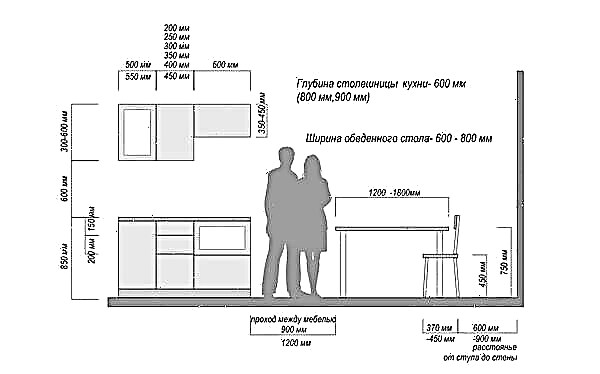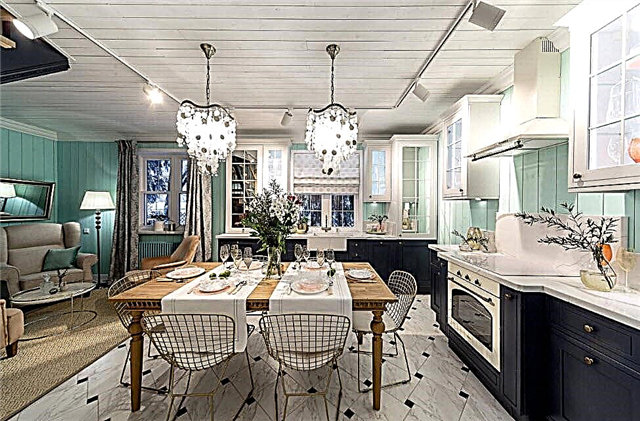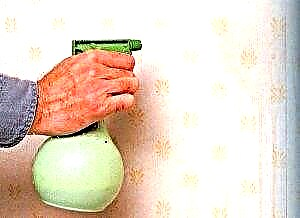Each owner of a summer cottage wants to make it a place of perfect relaxation from the bustle of the city.
Some focus on interior design, design and the implementation of modern stylistic ideas. Others value the naturalness of relaxation, try to recreate a cozy place right on the street.
To highlight this zone and create comfortable living conditions, a decorative arbor in the form of a canopy is installed inside.
It allows you to select a full-fledged area for outdoor recreation, and at the same time to hide from direct sunlight and light rain.
Ideas for giving
The origin of arbors is rooted in antiquity, the then “pergolas” were considered luxury and were intended exclusively for noble persons and members of the imperial family.
Today this building has gained wide popularity among all social classes. To reduce the cost and make the pergola affordable for everyone, modern materials and innovations in the construction industry have allowed.
Varieties of gazebos are divided into groups:
- Depending on location. The hinged structure can be built apart from other buildings, as well as attached to existing buildings on the site. An outdoor gazebo next to the bathhouse looks very practical. Such recreation areas are used as verandas.
- Differences in installation method. Arbor frames are divided into prefabricated and stationary. The prefabricated structure is characterized by low weight, lack of foundation and a low degree of protection from the weather. Stationary frames represent the solidity and viability of the owner. They are massive, often made using expensive finishes.
- Various roof modifications. Roofing equipment can be made using direct and inclined technologies. A straight roof is crowned with summer lightweight tents, an inclined roof model is single-pitched and gable. The modern trend is considered to be an arched roof frame, which provides for the installation of a rounded roof.
- The material of the canopies is also very different.. The most simple are wooden structures and metal frames. Technological gazebos are created using polycarbonate or metal.
If you want to translate your own idea into reality and create a truly unique gazebo, you can highlight the most attractive features of each of the above varieties and combine them in one project.
Attached to the house
An interesting simplified option is the gazebo, adjacent to one side of the main building. The main house, as well as the nearby bathhouse, can serve as a support.
Such arbors canopies are fixed on a steep wall, and the usual pillars become the second support for the frame.
Simplicity of construction does not require serious construction operations, and the assembly process consists in installing the necessary racks and securing the canopy itself.
When building an extension, you should focus on the type and size of the pavement. It is these parameters that determine the location of the supports and their degree of fixation.
With a small weight of the roof covering, the racks are sometimes installed without fixing in concrete.
With a pitched roof made of corrugated board
The fashion for octagonal recreation areas is already in the past, today lightweight frames from innovative materials are in demand.
A shed roof can be attached to any building, and there are also separate installation projects.
The advantages of single-slope projects are:
- Simple construction. Installation does not require specialized knowledge, and any person with a basic geometry course can build such a project.
- The versatility of the structure. The frame is installed in combination with other buildings, there is a separate arrangement option. In this case, the protective qualities of the pergola are not lost.
- The minimum cost and the shortest possible time of construction. The correct geometry of the structure allows the master to erect it in a few days.
- Wide functionality. Polycarbonate is a universal material that will create optimal protection in any weather.
The simplicity of the frame in such buildings is simultaneously combined with the reliability of the design, which makes the gazebo suitable for use in several summer seasons.
From metal and polycarbonate
High strength and corrosion resistance are characterized by metal canopies. Creating a polycarbonate protection on a metal frame allows you to build a virtually indestructible gazebo.
The metal frame can be installed in the following ways:
- Vertical stationary buildings, the strength of which is ensured by welding. Such structures are assembled sequentially, right at the location. For added reliability, the main posts are recessed in 150 cm concrete.
- Metal profile pipes (preferably of the correct square or rectangular shape) are bolted with additional rubber gaskets. This allows you to make a collapsible frame, which will be hidden during the winter period.
- The metal structure is placed on a solid concrete base, and the walls are laced with wood.
Pergolas and canopies made of metal are mounted as durable buildings, the operation of which is designed for a long period. With proper anti-corrosion treatment, the frame is completely protected from external influences.
Wooden beams pergolas
The construction of a decorative arbor made of wood requires the correct selection of building materials. There is no need to use thick logs, so a beam with dimensions of 10x10 cm will be the best option.
To create a slope, it will be sufficient to leave a margin of height of the front pillars of about 50 cm compared to the rear ones.
If foundation pouring is not planned, then before digging up the pillars, it is necessary to treat the wood with protective solutions.
Winding material is sometimes used. To create a reliable anti-fungal barrier even machine oil will allow.
Canopy arbor made of wood requires the installation of a solid roof. You can cover such a pergola with simple boards.
Cheap options are slate coating and decking. Metal tile is considered to be of higher quality and more expensive.
Half closed with barbecue
The internal layout of the gazebo is an important aspect of maintaining its functionality. The equipment of the building with a barbecue requires the creation of an extractor hood or a special hole for smoke extraction.
If you neglect such nuances and simply add the brazier to a regular gazebo, then you can refuse a comfortable stay - smoke will become the main drawback.
The best option is to create an open pergola for a barbecue, which, due to the half walls, will be well-blown.
For the summer period there is no need to build a massive structure that will limit natural blowing.
The intricacies of building on your own
The process of building your own gazebo should begin with the development of the project. It is enough to carry out the drawing with a minimum designation of parameters, which will allow you to accurately calculate the amount of material.
After creating a sketch, the owner of the site should decide on the important points:
- Location of the building. It is necessary to select the optimal place for the future gazebo taking into account the blowability, the location of the shade and the features of the landscape.
- Type of foundation. Assess the rational need for a solid foundation.
- Roofing and type of roof.
Before assembly, a list of the required tools and their actual availability is also checked.
Place selection: separate building or annex
Placing a gazebo in the country largely determines the capabilities and functionality of the future recreation area. Awnings and gazebos attached to the main building are well protected from blowing.
A warm wall allows you to spend less effort on heating the recreation area. There is no need to constantly shoe in order to go around the site to a separate arbor.
Often it is almost impossible to carry out an extension to the main building due to the features of the project, then the owners of the site choose a place at a relative distance from the house.
In the presence of dense vegetation and trees, sometimes the option of separate placement of the recreation area fits better into the landscape and the general style of the inner space of the cottage.
Installation and fastening of poles
Construction begins with the arrangement of a quality foundation, the purpose of which is to maintain the total weight of the structure. Foundation pouring is required exclusively for stone arbors or buildings made of other heavy materials.
In other cases, you can restrict yourselves to installing regular support posts.
The placement of the main columns for the canopy is performed as follows:
- Pre-excavated pits equidistant from each other. The depth of one pit is 0.25 of the length of the support itself.
- A substrate is crushed to the bottom - crushed stone, gravel is sometimes used. Then it is necessary to perform ramming of this peculiar pillow.
- Aligning the perpendicular in the pit, a stand is placed, the bottom of which is treated with protective compounds and wrapped in special antiseptic material.
- Concrete is poured into the holes obtained.
The readiness of the columnar base occurs after 2 days.
Roof mounting
The roof structure largely determines the protective abilities of the entire structure. Correct slope, reliable material and the absence of cracks allow you to create an impenetrable canopy.
Installation of roofing is carried out according to plan:
- The roof structure is assembled on the ground, due to its own small mass, it is easily installed without the help of construction equipment.
- The frame is pulled together by fasteners, securely fastened to poles. Supports must first be connected to each other.
- A symmetrical crate is created, on which the main cover of the canopy is laid.
Note: to increase the strength of the upper structure will help special washers made of plastic, which must be placed under the screws. They eliminate the possibility of loosening and resist vibration.
Study of dimensional drawings
To optimize the installation of the gazebo, you must first develop the most detailed drawing. Install canopies arbors with minimal residual materials is possible only with the correct calculation of all construction costs.
At the stage of choosing the type of pergola, studying projects on the Internet allows you to correctly distribute the available funds. Only after a thorough analysis of the ideological designs of several options can you choose the best one for your own site.
The main types of canopies
This type of construction refers to small architectural forms, which, depending on the type and design features, can be classified according to the following criteria:
| By location | Most often, there are attached systems that protect the space near the entrance or wall. But there can also be a variant of a separate building, most often these are country carports and arbors |
| According to the roof configuration | Options are possible with straight roofs - single-pitched or double-pitched, and complex systems - pyramids, polygons, arches and other similar shapes |
| By appointment | On this basis, it is possible to distinguish functional designs that serve their intended purpose - protection against rain and decorative, this option is more likely an element of decoration and can protect maximum from the sun |

Awnings for dachas made of fabric allow you to design the site in an original way, but they are unlikely to protect from rainfall
Hardware
This option is simple, although its appearance leaves much to be desired. Of course, forged elements can be used, but their price is very high, and it is unlikely that they can create such a structure with their own hands. But to make a simple carport for a car in the country with this solution seems to be the most preferred option.
Construction work can be divided into several stages:
- First, materials are selected for the future design, the ideal solution is profiled pipes 20x40 or any other size, the main thing is to ensure the necessary reliability and stability of the structure to wind loads. Round pipes or a metal corner are also suitable, but the appearance of these options is less attractive.
- Next, you need to dig holes for the installation of support columns and prepare concrete for fixing the elements. Particular attention should be paid to putting all the elements on the same level, otherwise your design will be crooked.
- After concreting, each column must be firmly fixed so that it does not change its position before setting concrete. In order for the solution to gain the necessary strength, at least several days must pass, and it is better to wait a week.
- The next stage is the welding or screwing of the transverse elements and the roof frame. The frame can be welded independently, but can be ordered ready-made and installed on supports.
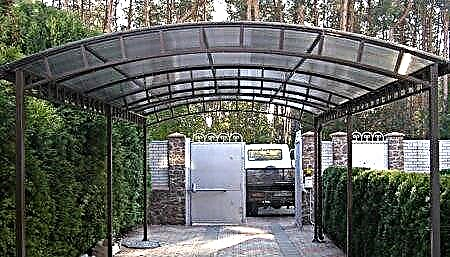
Canopies for a car in the country are made very simple - without unnecessary details and decorative elements
- It is easiest to use polycarbonate for a roof - this material is lightweight, high strength and resistant to ultraviolet radiation. In addition, it perfectly transmits light, which is also important for creating a comfortable environment.
Advice!
It is not worth saving and acquiring the thinnest polycarbonate, its thickness should be at least 6 mm, and better at all 8 mm, this guarantees the reliability and durability of the roof for many years.
In the photo: a large selection of colors - another important advantage of cellular polycarbonate
- The instructions for fastening sheets are very simple: special roofing screws with a rubber washer are taken, which are screwed to the base, it is important not to tighten the fastenings very much so as not to damage the roof.
Brick Buildings
If a gazebo is erected for a summer residence, then it makes sense to make the design more thorough. (See also the article Awning for giving: features.)
The works have the following features:
- It is best to pre-fill the screed on the site, and to fill the column foundation in the locations of the columns. This will ensure the strength of the base, since the weight of the materials is significant. Work can be continued a week after the concrete hardens.
- Columns are laid out from any brick you like to the desired height. As a rule, the rafter system is most often made of wood, but a metal frame can also be used.

Brick racks - a reliable foundation for any roof
- The roof can be anything from polycarbonate to slate, metal or soft sheets.
Advice!
It makes sense to use a brick in cases where it remains after the construction of the main buildings, so you can save and design all the buildings in a single style.
Wooden structures
If the canopy for the country house is an extension, then the easiest option is to use a tree. With it, you can build almost any design. (See also the article Marquee: Features.)
The work is simple: all the elements are cut into the necessary fragments and collected using nails or self-tapping screws. Polycarbonate canopies for summer cottages on a wooden frame - the most simple and budget solution to date.

This design is built very quickly and looks great
As you can see, such garden structures can be erected with minimal time and money. The main thing is to carry out all the work carefully in accordance with the recommendations.
Features
Pergolas serve as decoration of the site and, as a rule, are a continuation of the style ensemble of all buildings and garden furniture. Due to the variety of types, designs and materials of execution, each owner has the opportunity to choose a unique option that is most suitable for taste and wallet.
The main difference between a canopy and a full arbor is the absence of walls, parapets and an entrance. Often, gazebo canopies are lightweight and do not need to create a solid foundation. Such an open-type structure consists of vertical pillars on which the roof is held. The canopies look more “airy” in comparison with the monumental gazebos, do not burden the landscape design, and the savings in building materials add another plus to the piggy bank of the advantages of this type of building. Let us consider in more detail the types and designs of gazebos.
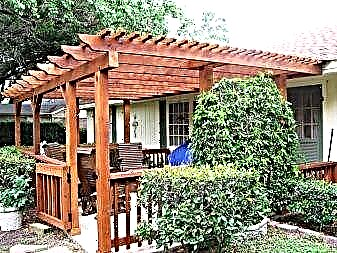

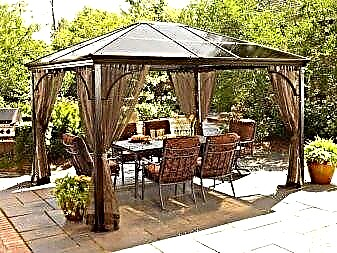
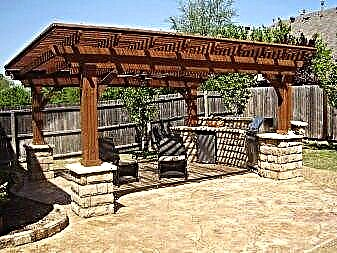
Varieties
Attachments may be freestanding or be part of another building.
- Free-standing ones include hinged tents, barbecue areas, pergolas.
- Attached arbors can serve as an open veranda near the house or bath. In this case, under a canopy you can equip not only a recreation area, but also a summer kitchen, and near the bathhouse there is a place for a small pool or font.


By design features, the canopies can be prefabricated (mobile) or stationary.
- Stationary gazebos are more durable, they are built from durable materials that can withstand atmospheric precipitation year-round.
- Mobile designs can be purchased ready-made, it is not difficult to assemble them. At the end of the season they are cleaned in a house or utility room along with all garden furniture.

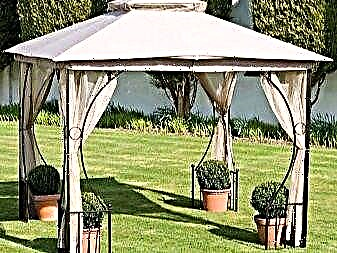
Roof
The main emphasis in the suspended structure is the roof.
The coating material must be durable, protect from rain and sun, but the geometry of the roof can be chosen for every taste:
- Straight. A flat roof or a stretched awning is the easiest option for a canopy if you need to quickly arrange a temporary resting place or lunch. However, with prolonged use, it has its drawbacks - precipitation will collect on a flat surface, which will lead to sagging or breakage.
- Single or gable construction. This option is more suitable for prolonged use of the gazebo - water will not linger on the roof. Shed buildings look good as extensions to a house or bath, and gable ones create the appearance of a neat house.
- Semicircular or arched. Recently, this form of roofing is becoming more and more popular - it maximizes space and protects from sunlight. Thanks to modern materials (waterproof fabrics or polycarbonate), you can make a domed top of the canopy with your own hands.




Materials
The material of the gazebo will largely depend on the general style of the summer residence.
However, if landscape design allows, then the canopy can be built from any affordable or available material.
- As a rule, support pillars are made of wooden beams, metal rods or cement-asbestos pipes of small diameter. In some cases, brick posts are built for stationary arbors, but this option is more time-consuming and costly. The listed materials are strong enough to support the weight of the roof.
- For the construction of the canopy, waterproof awnings are used (tarpaulins, polyester), wood, plastic or metal roofing on the frame.
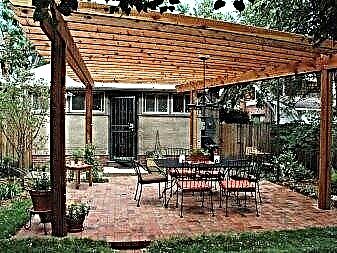



Design
Today it is the gazebo-canopies of various shapes and designs that are the best option for organizing a vacation spot. The most popular of them combine functionality - protection against precipitation and sunlight and aesthetic qualities - the canopy can become an individual feature of your site.

- Pergola. A real decoration of the garden, support for climbing plants and a cozy place to relax. The name itself is translated from Italian as "canopy" or "extension". The facility has long been used to maintain vines and create a shaded corner in Italian sun gardens. The design is made of pillars or columns with a domed or flat frame.
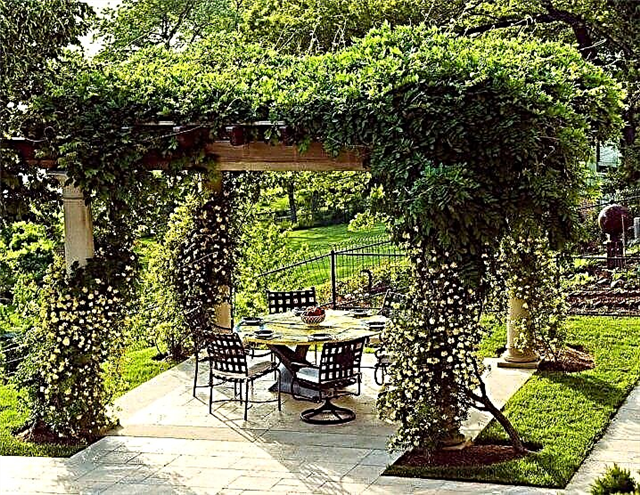
A classical pergola is a structure of repeating sections of the frame connected by transverse beams and twisted by dense stems of plants. The material for creating a pergola can be absolutely anything, the main thing is that the frame can withstand the weight of the weaving vine. Plants are selected based on climate preferences and characteristics - climbing roses, creepers, hops, wild grapes, clematis. The pergola can be a separate structure or adjoin the central part of the house and serve as a shaded arbor.
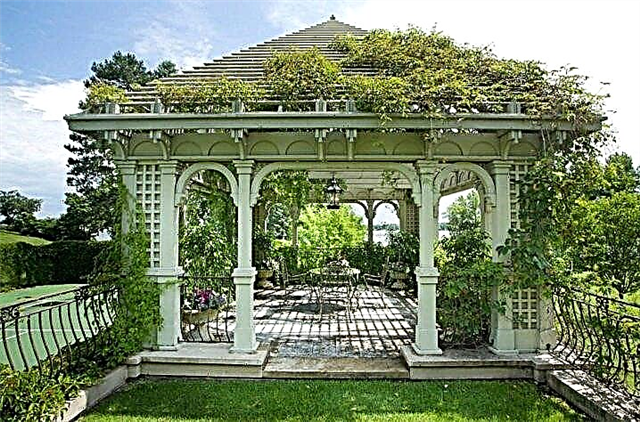
- Marquise. Another foreign invention designed to protect various street objects from rain and heat. This canopy does not have support pillars, but retains its weight due to the fixed frame. The main advantage of the marquise is the folding mechanism. Such canopies do not require dismantling, they are folded or twisted mechanically or automatically.
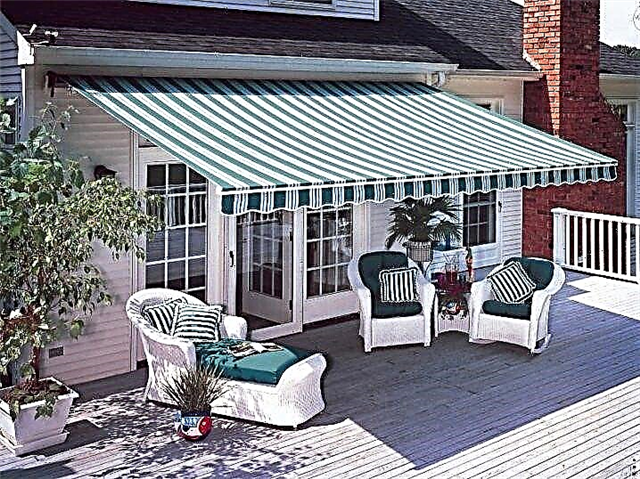
For an awning, an acrylic or polyester canvas of different thicknesses and colors is used. The fabric has good water-repellent and reflective properties, so it retains a presentable appearance and durability for a long time.


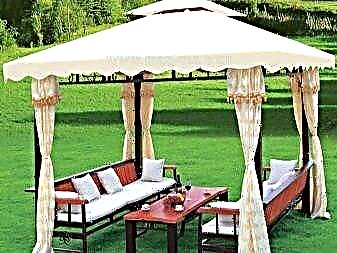
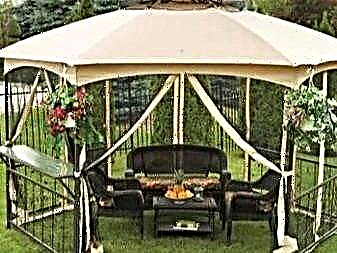
- Canopy for the barbecue. This is a reliable rain protection for barbecue. Such canopies with all the ease of construction require certain subtleties in the construction. They must be stable and fireproof.




As a rule, a barbecue area is located away from wooden structures and has a concrete or any other solid foundation. The canopy for the barbecue site is best thought out in advance, even at the stage of pouring the foundation, so that it is possible to firmly fix the support posts.

- The tent. The attractive form of this design is in demand among owners of voluminous open spaces. The tent is based on a solid frame made of metal rods or wooden beams, has a triangular or domed top made of various types of waterproof canvas. Often, for the decor of the tents, tulle or dense fabric is used to protect from the sun and insects. The fabric is matched to the color of the roof, and in the retracted position is attached to the supporting posts with ribbons or clips for curtains.
The resulting design resembles a picturesque oriental tent and serves as an ornament to the entire garden area. The stationary frame and durable roof tent do not need to be cleaned at the end of the season, and the curtains and mosquito net are removed and put away for storage until next spring.

- Pavilion. This lightweight construction can be called a kind of tents with the only difference being that the pavilions have a large square, are used as mobile structures to accommodate a large number of people during celebrations and picnics. The pavilion case is made of thin metal or plastic rods; the tent is made of rubberized fabric or transparent polyethylene fabric. Pavilions can have fabric or oilcloth fences at the level of the belt, mosquito nets or window openings. Easily laid out and cleaned after the celebration.

Do it yourself
If desired, and some construction skills, the gazebo can be done with your own hands without resorting to the help of specialists or buying expensive material options. Construction takes place in several simple steps, takes a little time, and If you have the tool and the required amount of materials, by the evening you can become the owner of a nice place for a summer vacation.
- Support poles are installed on a cleaned flat area. To do this, remove the top layer of the earth, remove the sod. The site is covered with sand or gravel, leveled with a rake.
- After that, support poles in an amount of at least four are dug around the perimeter of the site. The larger the size of the canopy, the more pillars will be required to hold the roof or awning firmly. The optimal distance between the posts varies from one and a half to two meters. The material used is a wooden beam, metal rods or cement-asbestos pipes of small diameter. For better stability, the supports can be poured with cement mortar, then your winter breeze and snowfall will not be scary.
- The supporting beams (frame) for the curtain web are selected depending on the type of roofing. Of course, the heavier the roofing material, the stronger the overlap should be. This applies to metal tile, slate and wood flooring. For this reason, heavy roofing material is rarely used in the construction of gazebos.
- The modern market offers a huge amount of light quality materials for a canopy that will not burden the structure: polycarbonate, polyester fabric, tarpaulin. If the gazebo is made in eco- or ethno-styles, then you can use rattan or reeds to create a roof.
Design Tips
In order for the resting place to be comfortable and harmonious, care should also be taken about the internal arrangement. In particular, to think over and lay out the flooring, because walking on the ground and sand in rainy weather is not very pleasant. The floor can be ordinary floor tiles, a dense layer of gravel or a wooden terrace.

Furniture for an open gazebo is best selected from materials resistant to precipitation. It can be a bright plastic table set, wooden furniture, a rattan rocking chair, deck chairs. As a decor, climbers, multi-colored pillows, floor or hinged flowerpots with flowers are used.

A short video review about a simple canopy in the courtyard, built by yourself, is waiting for you below.
Types of Canopies
In the construction of such an extension sooner or later there is a need for almost all owners of country houses. You can use it as a summer kitchen, garage, recreation area and for other purposes. And for starters, it’s worth finding out what types of canopies are and how they are different from each other.
The following types of canopies are distinguished:
- attached to the dwelling,
- pent,
- metal and polycarbonate,
- pergola on wooden stilts,
- half-closed with barbecue.
How to make a gazebo do-it-yourself canopy
The size of the gazebo will depend on the size of the plot and the house: for example, if this is a small cottage, then it is worth building a small pergola. The overall area will look better with a large rest area. The simplest construction is attached to the house. It is about its step-by-step assembly that will be discussed below.
Material selection
You should start with the selection of materials. This stage must be approached, relying on the intended purpose of the design. If you need a capital, durable gazebo, then it is best to make a metal frame. For portable structures, it is better to take wood.
As a roofing material, choose one that is suitable for the price, and also taking into account the strength characteristics:
Necessary tools
Before you build a gazebo, you need to check the availability of the necessary tools.
For a given goal you will need:
- plane,
- ax,
- jigsaw
- saw,
- hammer,
- nails
- screwdriver
- self-tapping screws
- building level,
- shovel,
- thick thread
- metal sleeves.
Instead of nails for working on wood, it is better to use self-tapping screws, since the former violate the structure of the fibers of the material, which leads to its premature damage. To fix massive parts, you should acquire metal corners covered with stainless steel and bolts of the appropriate size.
Foundation
To attach a canopy gazebo to the house, you should take care of the presence of a quality foundation. Foundation filling is required only for buildings that are built of stone or very heavy structures. In other cases, there will be enough support pillars.
Phased work:
- Land to clear of debris. If necessary, align the place.
- Transfer the size of the planned area from the drawing to the plot by marking. To do this, stakes should be driven along the perimeter of the territory, and a thread should be pulled between them.
- Dig out recesses to fit metal sleeves. Insert them into the pits and pour concrete.
Decoration and arrangement
You can decorate the canopy arbor in a variety of ways. Inside, they usually equip a relaxation area - for this they put up chairs, benches or swings, tables. If metal was used in building materials, then it should also be used in decorative elements. It can be, for example, curly candlesticks or stands for plants.
To the gazebo should hold the light. Usually connected to a home source of electricity. Considering that midges will fly to the lamps at night, you need to put a mid-catcher or cover the structure with a mosquito net. Instead of the latter, you can also use special curtains.
So, the easiest option for arranging a recreation area in the country is the construction of a gazebo-canopy directly next to the house. To implement the idea, it is better to take materials such as wood and polycarbonate. They are cheap, easy to use and look pretty attractive.
Main types
To choose a canopy arbor, you need to take into account your own wishes, financial capabilities and features of a specific summer cottage. Such designs are stationary and portable. Summerhouse arbors that can be carried are usually collapsible. Most often, portable structures are lightweight, their frame is made of plastic or metal. Directly the canopy is made of synthetic material, polyethylene or high-strength fabric.

Stationary gazebos most often have significant weight, so they do not move. In this regard, such designs are less convenient, but they have a longer service life, more reliably protect people from various external influences. Typically, such structures cannot be disassembled.




How to choose a place?
The gazebo can be installed where it is very beautiful: for example, by a man-made or natural lake, decorated with flowers of a stone slide. To make the design look more aesthetic, you can plant flowering shrubs next to it, decorate it with climbing plants.

Do not install the structure in the lowland. Such a cold place with high humidity will be bad for rest and relaxation.
Constructions
Canopies arbors differ in designs. There are several options.
- Semi-closed gazebos. The open opening of this building can be closed with a dense material that is resistant to liquid. Another option is glazing.

- Open constructions. To make such a gazebo as comfortable and more closed as possible, using a green hedge.

The roof can be inclined (gable or shed), straight, round, arched. Visors (inclined roofs) are especially convenient in use. Rain will not interfere with people in the gazebo, as water always flows down the ramp.

Important steps
You will need to do the following:
- First, select the place where you will install the gazebo. Then you will need to prepare the surface for installation.
- Create a foundation, wireframe.
- Make a roof.
Only high-quality materials and tools should be selected for construction work. Otherwise, it is possible that the design will not differ in durability.
Building
Start construction work as follows:
- To establish the supports, dig holes that will be at the same distance from each other. They should be fairly deep: approximately one fourth of the height of the column. Put there pillows made of gravel and rubble, carefully tamp everything.
- Insert into the recesses of the support. Before this, they will need to be impregnated to protect surfaces from fungus and mold. Using the building level and plumb line, check if the supports are installed correctly.
- Then you will need to make a foundation. Pour concrete into the pits and wait a few days.


Gable roof
The roof will need to be done as follows:
- Using screws and metal corners, connect the rafters (to make it more convenient, do it on the ground). Cut the gaps.
- On the ends, pull the supports with a board. The rafters will need to be attached to the pillars. Connect them together.
- Make a crate using a trim board. On it will need to put a roofing. The roof can be made as airtight as possible with plastic washers for self-tapping screws.
- On the floor, you can pour a screed of concrete, place gravel, put boards.

So you will create a stationary canopy on the base of the supports. If you want to use this structure as a gazebo, you can create a side crate. Some use similar designs as constructions for cars. They are multifunctional and very resistant to various atmospheric influences.

Plastic buildings
Today, many people prefer to create gazebos from PVC pipes made of plastic, metal, polypropylene. Such designs are distinguished by a long service life, ease, and at the same time problems with the implementation of installation work arise very rarely. You can make a sliding portable structure.
PVC pipe structures have certain disadvantages:
- The frame of such structures is not highly durable.
- From such arbors comes a rather unpleasant odor, they are toxic.
- Due to exposure to sunlight, PVC structures can become deformed.

Plastic is a material from which you can create a variety of shapes. You can easily build structures of various shapes: polygonal, semicircular, rectangular. For coating, you can use polycarbonate, a polymer that differs in density.
Polycarbonate
Polycarbonate has many advantages. The main advantages of this material:
- Ease of handling. From it you can get products of various shapes, such material bends easily. It is well suited for creating complex, unusual designs. Such a construction will become a unique highlight of your summer cottage, its wonderful decoration.
- Fire resistance.
- Long service life, durability. Such products are resistant to corrosion (in contrast to metal). They do not need to be treated with agents that protect surfaces from mold and fungus (unlike wood).
- Relatively light weight.


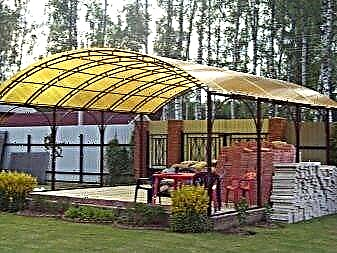

Polycarbonate can only be used when the structure is stationary. This is quite expensive material, and it can easily be damaged if you disassemble and carry the gazebo.
The frame can be metal, brick, wooden. If you want the structure to be light and small, you do not need to make a heavy foundation. Just install regular metal pins in the ground.
It is not recommended to make a polycarbonate roof for the structure where the grill will be located. In this case, it is worth choosing roof tiles, slate, decking, and for the frame - pipes or metal profiles. To remove smoke, you will need to make a pipe. This element in such structures is mandatory. If you do not remove smoke, you can get carbon monoxide poison when cooking kebabs.
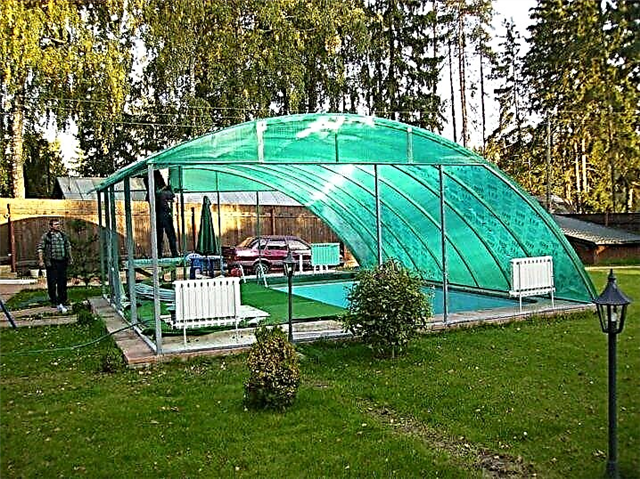
For the design with a barbecue, it is recommended to make a strip foundation, it is quite complex. To prevent the occurrence of a fire, it is necessary to install structures with a stove quite far from a bathhouse made of wood or a cottage. Bushes and trees that are next to such a structure must be removed or transplanted to another place.
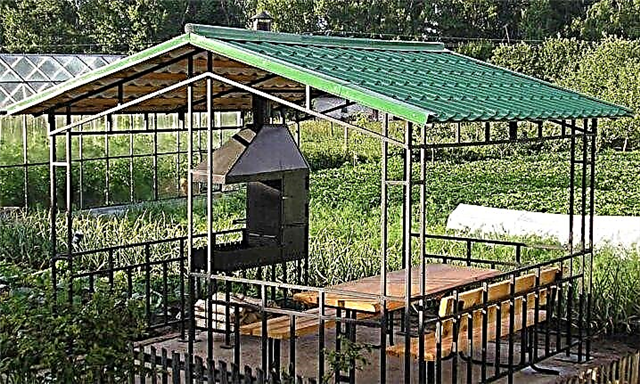
With barbecue
You need to build a gazebo with a barbecue in this order:
- Create a strip foundation. To do this, dig a fairly deep trench around the perimeter (approximately 0.4 m).
- Make a pillow: pour gravel on the bottom. Tamp it, place the reinforcing mesh on the bottom.
- Using the boards, make the formwork. Pour in concrete. Wait until the foundation has completely dried: it usually takes about a month.
- Use a fire-resistant brick to build the stove. Do this by applying a solution based on red clay.
- If you want the building to be presentable, cover the barbecue with cement mortar or facing brick.

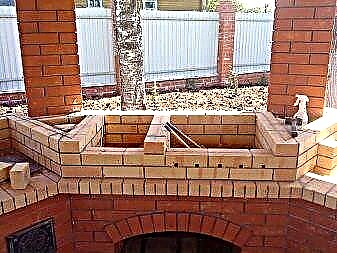
The grill oven should be built as follows:
- Create a pedestal for stove accessories and firewood.
- Build a firebox, stove.
- Create a pipe to regulate traction.
- Carry out the decorative cladding.
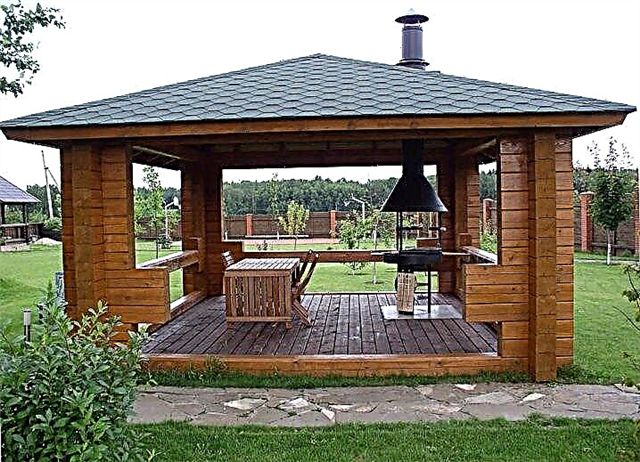
For firewood
When installing the stove, it is necessary to provide a woodpile where there will be firewood. A canopy arbor for firewood can be easily created independently. It will reliably protect them from precipitation. You can create such a structure quite quickly and without significant cash outlay. It is not at all necessary to make a rectangular arbor: it can be non-standard, designer.

Metal frame and rectangular shape
Rectangular structures with a metal frame are different:
- You can make the floor brick or create a foundation of concrete. So the wood will not rot.
- Some choose a polycarbonate roof. It is attached using rubber washers and bolts.
- Metal supports created with a welding machine are poured with concrete. In the ground they are quite deep (they are buried at about 1.5 m).

Garden tents
Today, many people choose garden tents for use in cottages. Most often, aluminum or plastic pipes are used to create their frame. Durable fabric material, most often synthetic, is used to make the tent itself. In such constructions, usually soft, transparent windows. The door can be draped using a mosquito net. Such structures are portable, prefabricated. Do not place the garden tent near a fire source.
The design, which is significant in size, can also be used to put a car there. Collecting such structures is quite easy: you just need to focus on the recommendations that are indicated in the instructions.
Hammocks
Hammock is a very convenient device that allows you to effectively relax and restore strength. This is usually called a piece of mesh or fabric material having a rectangular shape, which is located between the supports. Landlord owners who wish to relax in the shade usually hang a hammock between the trees. However, you can do without trees. You can independently create a canopy arbor with a hammock. Wherever such a design is located - the sun's rays will not bother you.


First decide where the structure will be located. Then dig pillars of metal or wood into the ground. It will be necessary to pour concrete into the pits. Hang a hammock using chains or strong, fairly thick ropes. As a canopy, you can use a polycarbonate sheet or fabric material. Fasten the canopy to the pillars.

It should be borne in mind that today in many stores finished designs with a hammock are sold. Consumers canopy canopies of various designs, shapes and colors. Typically, such structures can be disassembled. When assembling the structure, one should take into account the recommendations from the manufacturer (first carefully read the instructions).
Such a design can be placed anywhere without thinking about installing support poles, because such hammocks are portable. Such structures have a large number of advantages, but their cost is usually quite high. If you are still not sure that you are ready to give money for a hammock arbor, try to build such a structure yourself. This is nothing complicated: you only need to stock up on patience, perseverance and select materials that are of high quality.

